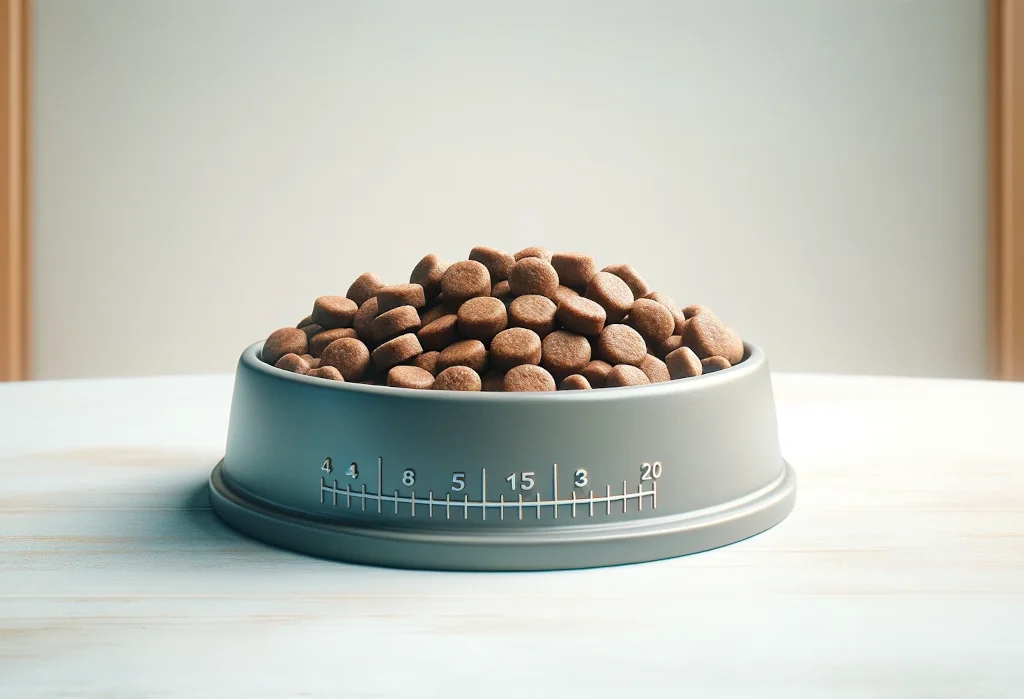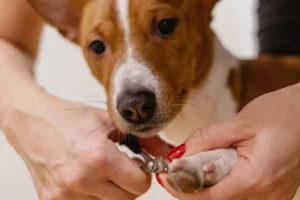Feeling like your dog is more “fluffy” than fit? We’ve all been there, staring into those big, pleading eyes, unsure how to say no to just one more treat. Yet, behind those adorable eyes lies a bigger issue – weight.
In this post, you’re going to get straight-to-the-point, actionable tips on how to feed your overweight dog to help them slim down without feeling deprived. Let’s turn those sad puppy eyes into happy, healthy ones!
Key takeaways:
- Use a kitchen scale to nail portion sizes, ensuring your dog’s diet is precisely measured for weight loss.
- Swap high-fat and sugar treats for low-calorie alternatives like crunchy baby carrots to keep treats in the healthy zone.
- Integrate playful exercise into daily routines, adjusting for your dog’s fitness level, to boost metabolism and joint health.
What’s the Ideal Weight for Your Dog?
Identifying the perfect weight for your furry friend is not just about numbers; it’s about understanding their unique needs based on breed, age, and size. A sleek Labrador might have a different ideal weight compared to a fluffy Pomeranian. The first step is a visit to the vet. Regular check-ups ensure your dog’s weight is on track and help catch any potential health issues early.
At home, you can do a simple “hands-on” test. Feel around your dog’s ribs and spine; you should be able to locate them without too much pressure but they shouldn’t be prominently sticking out. When looking down at them from above, a healthy dog will display a noticeable waist. This visual and physical check is a quick way to gauge if it’s time to adjust their diet or if they’re in their prime shape.
How Can You Measure the Right Food Portions?
Diving into the world of dog food labels might seem overwhelming, but getting the hang of it is easier than you think. The key is consistency and accuracy. Using measuring cups or a kitchen scale can make all the difference in serving the right portion sizes for your overweight pooch. Don’t just eyeball it; precision matters, especially when your dog is on a strict diet.
An often overlooked tool is the feeding guide on the back of your dog food package. It’s not just there for decoration; it provides valuable insights into serving sizes based on weight, age, and sometimes even breed. Remember, these are just guidelines. Your dog’s needs might vary, so adjust accordingly and consider all treats as part of their daily calorie intake. And yes, consistency is king – stick to a feeding schedule to help manage their weight effectively.
What Foods Should You Be Feeding Your Overweight Dog?
Feeding your overweight dog requires a tailored approach. Their diet should not only help them shed those extra pounds but also nourish their body. Focus on high-protein, low-fat foods. Protein helps maintain muscle mass during weight loss, while low fat helps reduce calorie intake.
Here are some guidelines:
- Lean meats: Chicken, turkey, and lean beef cuts are great protein sources.
- Healthy grains: Brown rice and barley provide fiber and energy without the excess calories that come with white rice or bread.
- Vegetables: Not all carbs are created equal. Carrots, green beans, and pumpkin can be excellent low-calorie treats or meal additions.
Avoid foods high in fat and sugars. This includes many human foods and cheap dog treats. The hidden sugars and fats in them can sabotage weight loss efforts.
And here’s the unique tip you won’t find just anywhere: consider incorporating fermented vegetables into your dog’s diet. Fermented foods can promote a healthy gut, aiding in digestion and potentially improving weight management. Just a spoonful of sauerkraut mixed in with their regular meal can make a difference. Remember, introduce any new food slowly to avoid digestive upset.
Armed with these insights, you’re well on your way to helping your dog achieve a healthy weight. Remember, the best diet for your dog is one that meets their specific nutritional needs while helping them slim down. Be patient and consistent, and you’ll see the pounds shed and their health improve.
Can Treats Be Part of a Weight Loss Plan?
Feeling guilty for wanting to treat your overweight dog? You’re not alone. It’s common for pet owners to think they’re doing harm when rewarding their dogs with treats, especially when weight loss is the goal. However, treats can still be part of your buddy’s weight loss journey, provided you make savvy choices.
First, consider low-calorie treats. These days, the market is flooded with excellent options that pack a tasty punch without adding much to your dog’s waistline. For instance, crunchy baby carrots or apple slices (without the seeds, of course) make for a fresh, nutritious snack. Remember, the aim here is to satisfy your dog’s craving for something tasty without the calorie guilt-trip.
Another route you might not have thought much about is non-food rewards. Every dog is different, but many find joy in non-edible forms of affection. A few extra minutes of playtime, a fun new toy, or even simple verbal praise and pets can be just as rewarding as food. This way, you’re reinforcing good behavior and strengthening your bond without any calories involved.
When you do treat, keep these pointers in mind:
- Always account for treats in the daily calorie intake. Treats should make up no more than 10% of your dog’s daily calories.
- Choose wisely and read labels. Look for treats high in protein and fiber but low in fat and sugar.
- Creative alternatives. Frozen blueberries or small pieces of boiled chicken can be heavenly treats that don’t break the calorie bank.
Remember, it’s about making thoughtful choices that contribute to your dog’s overall health and happiness. You don’t have to eliminate treats completely; just opt for healthier alternatives that align with your dog’s weight loss goals.
How Often and How Much Should You Exercise Your Dog?
Exercise is the perfect partner to a balanced diet in your dog’s weight loss odyssey. Not only does it help burn excess calories, but it also strengthens the heart, improves metabolism, and helps keep those joints limber. Yet, not all exercises suit every dog, especially if your pup is significantly overweight or has been a couch potato.
Start slow, especially if your dog isn’t used to regular physical activity. Begin with short walks, gradually increasing the distance as your dog builds endurance. Swimming is another low-impact exercise that’s particularly good for dogs with joint issues. The buoyancy of water supports the body and minimizes stress on joints while still providing a solid workout.
Diversify:
- Interactive games: Fetch, tug-of-war, or hide-and-seek encourage movement and mental stimulation.
- Doggy playdates: Socializing with other dogs is not just good for your dog’s mental health; it also encourages a lot of running around.
- Agility training: This can be a fun way to bond with your dog and provide intensive physical exercise.
Frequency and Duration : Aim for at least 30 minutes to 2 hours of activity daily, depending on your dog’s health, breed, and age. Always observe your dog for signs of fatigue or discomfort, and consult your vet to discuss the best exercise plan for your overweight dog.
But here’s a tip most might not mention: make exercise unpredictable and fun, not just for your dog but for you too. Ever thought of doga? Yes, yoga with your dog! It’s a unique way for both of you to stretch, bond, and relax together. While it may not burn as many calories as a run, it’s a novel way to mix things up and keep your dog mentally stimulated and engaged with you.
Making changes to your dog’s routine, be it diet or exercise, can be challenging, but it’s also incredibly rewarding. By approaching your dog’s weight loss journey with thoughtfulness and creativity, you’ll not only help him shed those extra pounds but also enjoy a healthier, happier life together. Remember, consistency is key, and every small step counts. Keep it up, and soon you’ll see your furry friend thriving, making all the effort well worth it.
Alex, a passionate animal lover, has experience in training and understanding animal behavior. As a proud pet parent to two dogs and three cats, he founded AnimalReport.net to share insights from animal experts and expand his knowledge of the animal kingdom.





